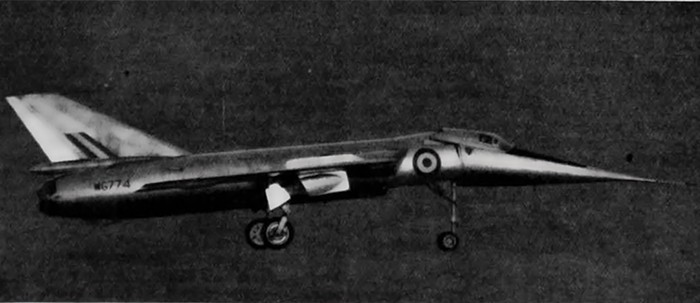
February 1957, Robert Lickley of the Fairey Aviation Company addressed the Royal Aeronautical Society. His subject was the Fairey Delta 2 (FD2), a supersonic research jet first displayed to the public two years earlier at Farnborough. But it was not until March 1956, when the FD2 set a flight airspeed record of 1,132mph, that the aircraft really took hold of the public’s imagination.
The UK’s Fairey Delta 2 hit a speed of 1,132 mph in 1956
The FD2’s design was completed in 1949, but the two prototype jets ordered by the Ministry of Supply were put on ice when production of the submarine-hunting Gannet was designated a ‘super-priority’. Reporting on Lickley’s lecture, The Engineer bemoaned the delay, finding it “surprising that, in a country with over a dozen aircraft constructors… the need to produce a deck-landing, turbo-prob submarine killer should hold back the construction of a supersonic jet research aircraft”.
Boasting a distinctive tailless delta-wing design, the single-engine FD2 showed exceptional speed in testing. Several supersonic flights were conducted over southern Britain, giving rise to a number of claims for damage caused by the resulting sonic booms. Accordingly, the test programme was moved to France, where Dassault Aviation engineers took inspiration from the aircraft; its influence was later seen in the delta-winged Mirage III fighter jet. Lickley’s lecture, printed in The Engineer a week after it was delivered, offered insights into the decisions that underpinned the FD2.
“The design which evolved was a delta-wing plan form of aspect ratio 2, having a Rolls-Royce ‘RA.5’ engine in the body with wing root intakes with frontal areas cut to a minimum and all possible excrescences removed,” Lickley explained.
“The major target and guiding principle in the whole design period was to get an aeroplane of minimum weight, with the smallest frontal and surface areas, while still remaining a straightforward aeroplane to handle in the air and on the ground, and yet at the same time large enough to house the ‘RA.5’ engine and sufficient fuel to enable worthwhile flights to be made.”
From the outset, Fairey’s test pilot Peter Twiss realised that the Delta 2 had the potential to hit speeds in excess of 1,000 mph. Despite having endured an engine failure and dead-stick landing early in the test programme, Twiss suggested pursuing the outright airspeed record, held at the time by the North American F-100 Super Sabre.
Support for the attempt was reportedly not forthcoming from the Ministry of Supply, however, nor indeed from Rolls-Royce. Nonetheless, Fairey pushed ahead, and on 10 March 1956, the Delta 2 set a new world airspeed record, achieving Mach 1.73 (1,132mph, or 1,811km/h). This marked a 37 per cent improvement on the previous record and made the FD2 the first aircraft to exceed 1,000mph in level flight. It also made Twiss the first man to fly faster than the Earth’s rotation, so that when flying west, the sun would actually appear to move backwards in the sky. In the wake of the Delta 2’s achievements, The Engineer was circumspect.
“Gratification at our possession of the ‘Triple Crown’ of speed records must not, however, blind us to the fact that, without doubt, the funds allotted to the ‘FD2’ were intended to contribute to the defence of this country,” wrote our predecessors. “It would be a fallacy to believe that research on supersonic, as distinct from hypersonic, flight is no longer necessary for military purposes. The fact that this country could be rendered uninhabitable by long-range bombardment with fusion warheads is no reason why it should be exposed to the far cheaper and more easily mounted attack of bombers with fission missiles.”
In spite of the success attained by the FD2, the concept was never developed into a production aircraft, and by 1973 both prototypes had been retired. But the legacy of its design could be seen in Concorde, in particular in the aircraft’s droop-nose. One of the Delta 2s would go on to be converted into the BAC 221, which served as a testbed for Concorde. The original classic delta-wing was replaced with the ogee delta, while the drooped nose was retained. Both features would later go on to become hallmarks of the supersonic passenger jet.




Report highlights significant impact of manufacturing on UK economy
Note to Evil Villain/Dave 2020. Thatcher was PM for _11_ years, from 1979 to 1990 so no one under the age of 34 was even born when she left office....